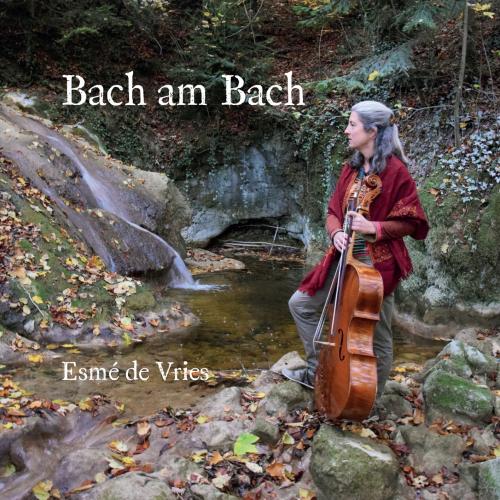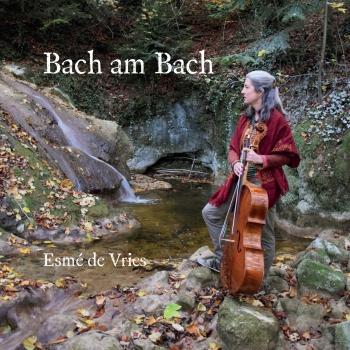
Bach am Bach Esmé de Vries
Album Info
Album Veröffentlichung:
2023
HRA-Veröffentlichung:
26.01.2023
Label: VDE-GALLO
Genre: Classical
Subgenre: Chamber Music
Interpret: Esmé de Vries
Komponist: Johann Sebastian Bach (1685–1750)
Das Album enthält Albumcover
- Traditional: Vem kan segla förutan vind:
- 1 Traditional: Vem kan segla förutan vind 02:41
- Domenico Gabrielli (1659 - 1690): Ricercare for Cello Solo No. 3 in D Major:
- 2 Gabrielli: Ricercare for Cello Solo No. 3 in D Major 03:50
- Johann Sebastian Bach (1685 - 1750): Cello Suite No. 2 in D Minor, BWV 1008:
- 3 Bach: Cello Suite No. 2 in D Minor, BWV 1008: I. Prélude 03:44
- 4 Bach: Cello Suite No. 2 in D Minor, BWV 1008: II. Allemande 03:38
- 5 Bach: Cello Suite No. 2 in D Minor, BWV 1008: III. Courante 02:30
- 6 Bach: Cello Suite No. 2 in D Minor, BWV 1008: VI. Sarabande 04:36
- 7 Bach: Cello Suite No. 2 in D Minor, BWV 1008: V. Menuets I & II 03:17
- 8 Bach: Cello Suite No. 2 in D Minor, BWV 1008: VI. Gigue 02:53
- Giovanni Battista Vitali (1632 - 1692): Passa Galli per la lettera E:
- 9 Vitali: Passa Galli per la lettera E 01:55
- Anonymous: Bach am Bach, Lied des Wassers (Arr. By Esmé de Vries, after Bach, "Nun komm’ der Heiden Heiland" BWV 659):
- 10 Anonymous: Bach am Bach, Lied des Wassers (Arr. By Esmé de Vries, after Bach, "Nun komm’ der Heiden Heiland" BWV 659) 05:33
- Giuseppe Maria Dall'Abaco (1710 - 1805): Capriccio primo:
- 11 Dall'Abaco: Capriccio primo 03:25
- Johann Sebastian Bach: Cello Suite No. 3 in C Major, BWV 1009:
- 12 Bach: Cello Suite No. 3 in C Major, BWV 1009: I. Prélude 03:49
- 13 Bach: Cello Suite No. 3 in C Major, BWV 1009: II. Allemande 03:53
- 14 Bach: Cello Suite No. 3 in C Major, BWV 1009: III. Courante 03:26
- 15 Bach: Cello Suite No. 3 in C Major, BWV 1009: IV. Sarabande 04:11
- 16 Bach: Cello Suite No. 3 in C Major, BWV 1009: V. Bourrées I & II 04:19
- 17 Bach: Cello Suite No. 3 in C Major, BWV 1009: VI. Gigue 03:30
- Giovanni Battista Vitali: Ruggiero per la lettera B:
- 18 Vitali: Ruggiero per la lettera B 02:35
Info zu Bach am Bach
Vem kan segla is an 18th-century song from Åland (an island between Sweden and Finland) sung in Swedish. Folk songs from around the world were a source of musical pleasure for me in my youth.
I remember a hike in the Alps where, after a long climb uphill, I arrived at a wildly flowing mountain stream. I was alone. The music of the water elicited from my soul one of these songs and with abandon I let my voice melt with the sparkling water. Thus Lied des Wassers was born.
This recording is a dialogue between the babbling water of a stream in the Jura (where I live) and the sounds of the cello. Bach am Bach (Bach by the stream) is a hymn to the water and leads you to that hidden place, deep inside, where nature and music come together in harmony and emotions can flow freely.
A funny fact is that Veit Bach (1555-1619), the ancestor of the Bach family, lived 'am Bach', in a water mill. He was a miller and baker. In his spare time, he played a kind of small lute whose sounds he made dance to the natural metronome of the water wheel. Gilles Cantagrel writes in his book The Mill and the River: " Born under the sign of the fish, Johann Sebastian Bach is attached to this image of water. By the name of his forefathers, Bach is the river. " And further: " This movement of flowing water, which he so loved to incorporate as a motif, became one of his musical signatures."
I have given each suite a prologue and an epilogue in the form of short pieces for solo cello, written in the same key or the eponymous major or minor variation. Domenico Gabrielli (1659- 1690) can be seen as one of the founding fathers of the cello as a solo instrument. His 1689 collection of seven ricercari, two sonatas and a canon for two cellos is the first work in the history of the cello to be titled 'Violoncello'. With Giovanni Battista Vitali (1632-1692) began the famous cello school of Bologna. Vitali was Gabrielli's teacher and he wrote a series of variations for 'Violone' on well-known dances from the 17th century . Dutch-born Italian composer Giuseppe Maria Clemens Dall'Abaco (1710-1805) seems to build on Gabrielli's ricercari from Bologna with his 11 capricci for solo cello.
I invite everyone to close their eyes and hear, feel and experience the sounds of Bach am Bach. (Esmé de Vries)
Esmé de Vries, cello
Keine Biografie vorhanden.
Dieses Album enthält kein Booklet












